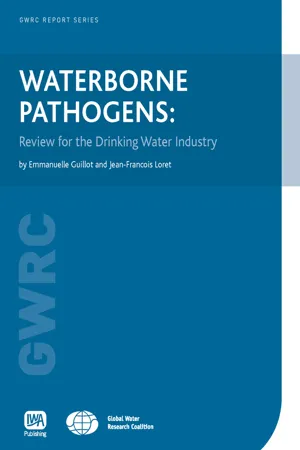
Waterborne Pathogens
Review for the Drinking Water Industry
- 194 pages
- English
- PDF
- Available on iOS & Android
About This Book
Infectious diseases caused by pathogenic bacteria, viruses and protozoa, are the most common and widespread health risk associated with drinking water. Most waterborne pathogens are introduced into drinking water supplies by human or animal faeces (enteric pathogens) but they can also exist naturally in water environments as indigenous aquatic micro-organisms. Controlling the risks related to these pathogens is a permanent challenge for the water industry. In addition to the constantly evolving range of pathogens to consider, assessing and managing such risks requires the integration of information issued by a wide range of disciplines. The necessary knowledge is however still sketchy and incomplete for most pathogens, and research efforts are necessary to fill the remaining gaps of knowledge.
The purpose of this study is to provide an updated, comprehensive review of current knowledge on a selection of pathogens of interest for the drinking water industry, and to identify the remaining gaps of knowledge and thus the necessary research to be conducted. Emphasis has been laid on the information needed to assess and manage the risks related to each of these pathogens in drinking water production and distribution.
The pathogens considered in this review were selected on the basis of:
- Their recognized or highly suspected transmission by drinking water through ingestion, inhalation, or contact
- Their recognized pathogenic character for humans
- The severity of their health effects
Each micro-organism in this study is described in a summary fact sheet composed of the following items: microbiology, human health effects, geographical distribution, epidemiology, ecology, inactivation/removal, surrogates, environmental detection and research needs. Since much remains unknown about many aspects that are common to viruses, the study features a general section on virus research needs. A special section summarizes the risk management research conducted on waterborne pathogens. Finally, the conclusion gives an overview of the main gaps in current knowledge on waterborne pathogens.
Visit the IWA WaterWiki to read and share material related to this title: http://www.iwawaterwiki.org/xwiki/bin/view/Articles/WaterbornePathogens
Frequently asked questions
Information
Table of contents
- Half title page
- Title page
- Copyright page
- Contents
- Foreword
- Acknowledgements
- Introduction
- Bacteria
- Viruses
- Conclusions
- References
- Annex 1